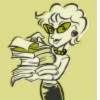 Hoffman, Eric and Celeste Henriquez (Ill.). 1999. BEST BEST COLORS. St. Paul, MN : Redleaf Press. ISBN 9-7818-8483-469-1
Hoffman, Eric and Celeste Henriquez (Ill.). 1999. BEST BEST COLORS. St. Paul, MN : Redleaf Press. ISBN 9-7818-8483-469-1PLOT SUMMARY
Nate struggles to decide which color is his “best, best.” Along the way, he chooses a favorite mamma—first one, then the other, then neither. When he cannot decide who his best friend is, he wonders, “Do I have to pick just one?” Finally, after making a rainbow flag with his mammas, Nate realizes he doesn’t have to choose just one. They can all be his “best, best.”
CRITICAL ANALYSIS (INCLUDING CULTURAL MARKERS)
BEST BEST COLORS is a story which illustrates a typical conundrum for young children: the exclusivity of choosing favorites. As Nate capriciously chooses favorites throughout the story, he is surrounded by a diverse assortment of family and friends. Among the diversities addressed are ethnicity, family structure, and abilities. This diversity is primarily conveyed through the illustrations rather than overtly discussed in the story.
The ethnicities represented in BEST BEST COLORS are African-American, Anglo, Asian-American, and Hispanic. Three of these cultures are represented within the family of the main character, Nate. Nate and Mamma Laura are black, Mamma Jean is Anglo, and Nate’s sister is Asian-American. While none of these ethnicities are discussed in the text, Henriquez uses coloration and facial features to portray non-stereotypical examples of each. Another important facet of this book’s multicultural appeal is the fact that it is bilingual. In fact, the entire series of which it is a part, “Anti-Bias Books for Kids,” has been translated into Spanish.
Hoffman also addresses diversity in family structure. This diversity is alluded to in an unobtrusive manner. Nate refers to his mammas, but not the fact that he has two mammas. Nor is it mentioned that other families might not be the same. The only overt textual reference to gay and lesbian culture is when his mammas are showing Nate a rainbow flag, “Look what we got for the Pride Parade.” Even this reference to gay culture could be overlooked by young readers or older readers who are not well-informed. Another example of diversity in family structure is Nate’s sister, who is most likely adopted. She is seen but not heard. Indeed, the reader is aware of her existence solely because of the illustrations.
Finally, differently-abled diversity is included in BEST BEST COLORS. One of Nate’s friends, Mandy, uses a wheelchair. Again, this representation of a parallel culture is known only because of the illustrations. No mention of her handicap is made in the text. Mandy’s use of a wheelchair is not so much a character development tool, rather it is a detail in the illustrations.
Rather than promote diversity, Eric Hoffman’s primary thrust appears to be helping readers deal with the issue of choosing exclusive favorites. On the other hand, Henriquez’ primary intention is to imbue the story with diversity and multiculturalism. Being part of the “Anti-Bias Books for Kids” series is most likely the rationale behind the plethora of cultures represented in BEST BEST COLORS. However, it is a bit heavy handed. Just as a book about any ethnicity can be overwhelmed by too many cultural references, so too may be a book about diversity and tolerance in general.
REVIEW EXCERPTS
“The engaging story is enhanced by lively full-page illustrations depicting a multicultural cast of interesting characters” (Day, p. 5).
“A ‘Note to Parents, Teachers, and other Caregivers’ at the end of each book suggests follow-up activities and discussion topics. Overall, these purposeful titles meant to encourage readers to think about these issues fall short in the execution of their mission. (Library Journal, 1999)*
*Note: The author of this review, Kristina Aaronson of Bethel Elementary School Library in Vermont, includes examples from three of the four titles in this review of the Anti-Bias Books for Kids series. BEST BEST COLORS is not mentioned.
Day, Frances Ann. 2000. Lesbian and gay voices: An annotated bibliography and guide to literature for children and young adults. Westport, CN : Greenwood Press.
Library Journal review obtained from Amazon.com and accessed at: http://www.amazon.com
CONNECTIONS
Other books in the Anti-Bias Books for Kids series:
PLAY LADY, ISBN 978-1884834615
NO FAIR TO TIGERS, ISBN 978-1884834622
HEROINES AND HEROES, ISBN 978-1884834684
Related website:
A WORLD OF DIFFERENCE® Institute

No comments:
Post a Comment